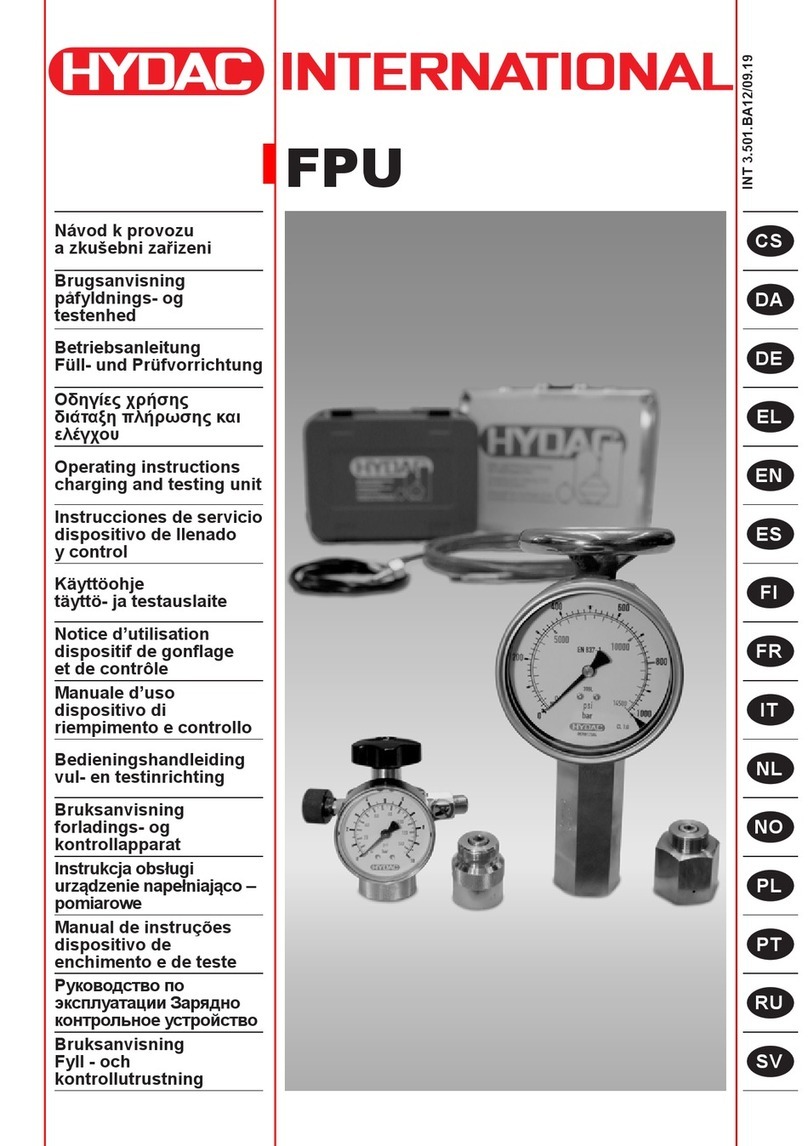4Charging & Gauging Units
PN#02068202 • ACU1403-1605 / 03.14
ACCUMULATORS
Checking Gas
Precharge Pressure
Connect the appropriate charging and
gauging unit to the accumulator following
the instructions under “Preparation” (see
page 2). Note: Temperature affects the
gas precharge pressure, please refer to
“Temperature Effect” (see page 2).
FPS Unit
Turn T-handle “A” clockwise a maximum of
3 full turns from the full counterclockwise
position. The gauge needle should indicate
the existing gas precharge pressure. If there
is no gas precharge pressure indicated
or if it is too low or too high, please follow
instructions under the appropriate section,
either “Pressure Release” (see below)
or “Charging” (to right). If desired gas
precharge pressure registers, please follow
the instructions under “Removal of Charging
and Gauging Unit” (see page 5).
FPK Unit
Turn T-handle counter clockwise a
maximum of 3 full turns. The gauge needle
should indicate the existing gas precharge
pressure. If there is no gas precharge
pressure indicated or if it is too low or
too high, please follow instructions under
the appropriate section, either “Pressure
Release” (see page 3) or “Charging” (see
page 3). If desired gas precharge pressure
registers, please follow the instructions
under “Removal of Charging and Gauging
Unit” (see page 4).
Pressure Release
With the appropriate charging and gauging
unit attached as previously described,
gas precharge pressure can be released
by carefully opening manual bleed valve.
Release the gas precharge pressure very
slowly until the desired gas precharge
pressure is reached (this insures that the
gas temperature does not fluctuate greatly,
providing and accurate gas precharge
pressure). Close the manual bleed valve.
Allow the gas precharge pressure to
stabilize. (5 to 10 minutes) recheck, adjust if
required. Once the desired gas precharge
pressure is reached, please follow the
instructions under “Removal of Charging
and Gauging Unit” (see page 5).
Charging
Warning!
Never use oxygen or air - this could
cause an explosion! Use dry nitrogen or
other recommended gases.
HYDAC recommends the use of a pressure
regulator on the commercially available
nitrogen bottle to regulate pressure to the
charging and gauging unit.
Note: Full nitrogen pressure may damage
the gauge. Connect the charging hose to
a commercially available nitrogen bottle
by means of the G4 adapter (other adapters
are available, check with factory for type); the
adapter connects to the cap screw “G1”.
Connect cap nut of the charging hose to
check valve of the charging and gauging
unit (see fig. 1). Connect the appropriate
charging and gauging unit to the
accumulator by following the instructions
previously described (see page 2).
Initial Charging
When charging an accumulator that has no
initial gas precharge, allow 20 to 30 minutes
for the gas temperature and thus pressure
to stabilize. Recheck the gas precharge
pressure and adjust if necessary.
FPS Unit
Turn T-handle clockwise 3 full turns.
Proceed to “Filling”.
FPK Unit
Turn T-handle counter clockwise 3 full turns.
Proceed to “Filling”.
FPK Unit (with adapter FPK/SB)
Turn T-handle clockwise 3 full turns.
Proceed to “Filling”.




























